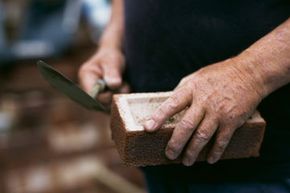Key Takeaways
- Laying a brick path is more approachable than building a brick wall, as paths generally do not require mortar and involve simpler techniques.
- Preparing a solid foundation involves digging a trench, laying down landscape fabric, adding layers of gravel and sand, and compacting each layer to prevent settling and movement.
- Lay the bricks in the desired pattern and then compact them into the sand for stability. Finish by sweeping sand into the cracks and watering the area to settle the sand, ensuring the path remains even and stable.
Brick walls and paths offer that sturdy, old-fashioned, classic quality that will never go out of style or look dated. But it looks so simple that it seems like something you want to do yourself -- especially after the shock of seeing an estimate from a professional bricklayer. If you're curious as to whether you can lay your own brick, the short answer is yes. It's certainly possible to lay brick paths or even walls without needing to hire a professional. But depending on the scope of the project, it may be time-intensive, or require some heavy-duty equipment and materials -- as well as a bit of masonry skills. It's not a project for the casual homeowner without handyman skills.
A brick wall, which will require mortar, is a difficult project. Experts say that you shouldn't even try to build a brick wall over 4 feet high (1.2 meters) on your own unless you are an experienced bricklayer [source: Hessayon]. A short wall, on the other hand, might be a manageable task. However, it would be hard to teach yourself bricklaying simply by reading a book. It's best to watch an experienced bricklayer firsthand. If that's not possible, at the very least you should try to find and study tutorial videos on the process. It will take about 40 to 50 hours of practicing brickwork on a sample wall before you can produce a good-looking and structurally sound wall [source: LearntoLayBrick].
Advertisement
The major materials are bricks and mortar. Although bricks generally come in standard sizes, they vary greatly in the selection of texture, weather-resistance and color. Mortar is made of about four parts sand to one part cement, plus some plasticizer to make it more workable. You'll also need special tools, especially a trowel for laying and smoothing the mortar. A spirit level and a string line held down with pins will help keep your wall level and straight. A hammer and chisel will be necessary for splitting some bricks in half for the ends of the wall.
Another factor in brickwork is the pattern of laying them, also called the bond. Running bond is a common pattern, where the bricks are laid lengthwise in a staggered pattern. This is effective at maximizing the strength of the wall -- both by distributing the load and helping to resist lateral forces on the wall.
If you do decide to lay brick yourself, what else should you know going into it?
Advertisement

